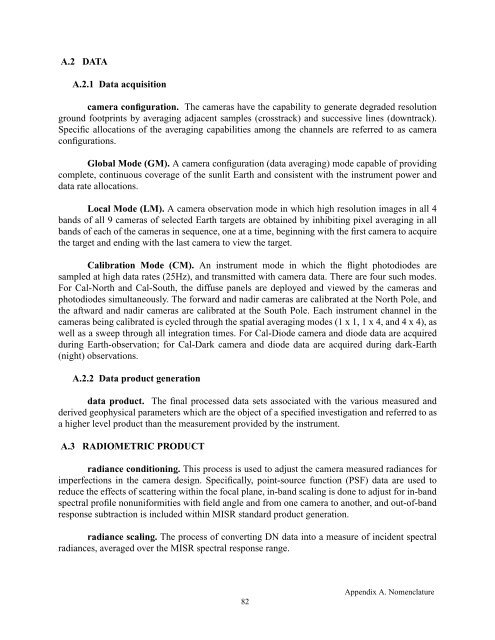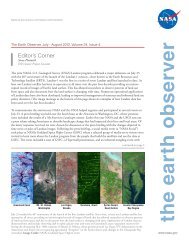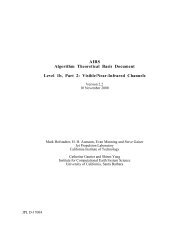MISR: In-Flight Radiometric Calibration and Characterization Plan
MISR: In-Flight Radiometric Calibration and Characterization Plan
MISR: In-Flight Radiometric Calibration and Characterization Plan
Create successful ePaper yourself
Turn your PDF publications into a flip-book with our unique Google optimized e-Paper software.
A.2 DATAA.2.1 Data acquisitioncamera configuration. The cameras have the capability to generate degraded resolutionground footprints by averaging adjacent samples (crosstrack) <strong>and</strong> successive lines (downtrack).Specific allocations of the averaging capabilities among the channels are referred to as cameraconfigurations.Global Mode (GM). A camera configuration (data averaging) mode capable of providingcomplete, continuous coverage of the sunlit Earth <strong>and</strong> consistent with the instrument power <strong>and</strong>data rate allocations.Local Mode (LM). A camera observation mode in which high resolution images in all 4b<strong>and</strong>s of all 9 cameras of selected Earth targets are obtained by inhibiting pixel averaging in allb<strong>and</strong>s of each of the cameras in sequence, one at a time, beginning with the first camera to acquirethe target <strong>and</strong> ending with the last camera to view the target.<strong>Calibration</strong> Mode (CM). An instrument mode in which the flight photodiodes aresampled at high data rates (25Hz), <strong>and</strong> transmitted with camera data. There are four such modes.For Cal-North <strong>and</strong> Cal-South, the diffuse panels are deployed <strong>and</strong> viewed by the cameras <strong>and</strong>photodiodes simultaneously. The forward <strong>and</strong> nadir cameras are calibrated at the North Pole, <strong>and</strong>the aftward <strong>and</strong> nadir cameras are calibrated at the South Pole. Each instrument channel in thecameras being calibrated is cycled through the spatial averaging modes (1 x 1, 1 x 4, <strong>and</strong> 4 x 4), aswell as a sweep through all integration times. For Cal-Diode camera <strong>and</strong> diode data are acquiredduring Earth-observation; for Cal-Dark camera <strong>and</strong> diode data are acquired during dark-Earth(night) observations.A.2.2 Data product generationdata product. The final processed data sets associated with the various measured <strong>and</strong>derived geophysical parameters which are the object of a specified investigation <strong>and</strong> referred to asa higher level product than the measurement provided by the instrument.A.3 RADIOMETRIC PRODUCTradiance conditioning. This process is used to adjust the camera measured radiances forimperfections in the camera design. Specifically, point-source function (PSF) data are used toreduce the effects of scattering within the focal plane, in-b<strong>and</strong> scaling is done to adjust for in-b<strong>and</strong>spectral profile nonuniformities with field angle <strong>and</strong> from one camera to another, <strong>and</strong> out-of-b<strong>and</strong>response subtraction is included within <strong>MISR</strong> st<strong>and</strong>ard product generation.radiance scaling. The process of converting DN data into a measure of incident spectralradiances, averaged over the <strong>MISR</strong> spectral response range.82Appendix A. Nomenclature







